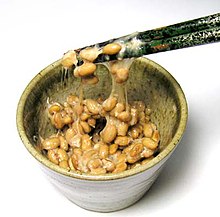Natto, Japanese soybean-based vegetarian food
Strictly
vegetarian food is rare since even vegetable dishes are flavored with
the ubiquitous dashi stock, usually made with katsuobushi (dried
skipjack tuna flakes), and are therefore pescetarian more often than
carnivorous. An exception is shōjin-ryōri (精進料理), vegetarian dishes developed by Buddhist monks. However, the advertised shōjin-ryōri at public eating places includes some non-vegetarian elements. Regarding vegetarianism, it is worth mentioning fucha-ryōri (普茶料理),
introduced from China by the Ōbaku sect (a sub-sect of Zen Buddhism),
and which some sources still regard as part of "Japanese cuisine".The
sect in Japan was founded by the priest Ingen (d. 1673), and is
headquartered in Uji, Kyoto. The Japanese name for the common green bean
takes after this priest who allegedly introduced the New World crop via
China. An interesting aspect of the fucha-ryōri practiced at the temple
is the wealth of modoki-ryōri (もどき料理 "mock foods"),
one example being mock-eel, made from strained tofu, with nori seaweed
used expertly to mimic the black skin. The secret ingredient used is
grated gobo (burdock) roots.
Dr. Masakazu Tada, Honorary Vice-President of the International Vegetarian Union
for 25 years from 1960, stated that "Japan was vegetarian for a 1,000
years". Although this is not totally true, British journalist J. W. Robertson Scott
reported in the 1920s that the society was 90% vegetarian. 50–60% of
the population only ate fish on festive occasions, probably more because
of poverty than for any other reason.














0 comments:
Post a Comment